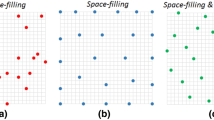Abstract
This paper proposes an adaptive mechanism for improving the availability efficiency of green component design (GCD) process. The proposed approach incorporates a wide range of GCD strategies to increase availability of the recycled/reused/remanufactured components. We have also designed a self-adjusting mechanism to enhance the versatility and generality of a genetic algorithm (GA) to improve GCD availability efficiency. The mechanism allows refinement of the GA parameters for the selections of operators in each generation. Our research contribution includes the development of a novel mechanism for the evaluation of optimal selections of reproduction strategies, adjustment and optimization of the crossover and mutation rates in evolutions, and design of Taguchi Orthogonal Arrays with a GA optimizer. The effectiveness of the proposed algorithms has been examined in a GCD chain. From the experimental results, we can conclude that the proposed approach resulted in better reproduction optimization than the traditional ones.




Similar content being viewed by others
References
Abubakar M, Babangida S (2012) Inventory ordering policies of delayed deteriorating items under permissible delay in payments. Int J Prod Econ 136:75–83
Alfaro-Cid E, McGookin EW, Murray-Smith DJ (2009) A comparative study of genetic operators for controller parameter optimization. Control Eng Pract 17:185–197
Balin S (2011) Parallel machine scheduling with fuzzy processing times using a robust genetic algorithm and simulation. Inf Sci 81:3551–3569
Bolmsjo G, Olsson M (2005) Sensors in robotic arc welding to support small series production. Ind Robot: Int J 32:341–345
Brouwer AE, Cohen AM, Nguyen M (2006) Orthogonal arrays of strength 3 and small run sizes. J Stat Plan Inference 136:3268–3280
Cao H, Du Y, Liu F, Shu L, Chen X (2012) Customised design of remanufactured products and optimisation model for cores reuse. Int J Comput Integr Manuf 25:741–749
Chao KM, Norman P, Anane R, James A (2002) A chain based approach for engineering design. J Comput Ind 48:17–28
Chen K (2012) Procurement strategies and coordination mechanism of the supply chain with one manufacturer and multiple suppliers. Int J Prod Econ 138:125–135
Chiu CC (2001) The analysis of related total cost of postponement strategies for supply chain management, Master Thesis, Chau-Tong University
DeJong K (2007) Parameter setting in EAs, a 30 year perspective, parameter setting in evolutionary algorithms, chapter 1. Springer, pp 1–18
Dhouib K, Gharbi A, Ben Aziza MN (2012) Joint optimal production control preventive maintenance policy for imperfect process manufacturing cell. Int J Prod Econ 137:126–136
Eiben AE, Michalewicz Z, Schoenauer M, Smith JE (2007) Parameter control in evolutionary algorithms, parameter setting in evolutionary algorithms, chapter 2. Springer, pp 19–46
Erel E, Sabuncuoglu I, Gurhan KA (2004) Analyses of serial production line systems for interdeparture time variability and WIP Inventory Systems. Int J Oper Quant Manag 10:275–295
Fazlollahtabar H, Hassanzadeh R, Mahdavi I, Mahdavi-Amiri N (2012) A genetic optimization algorithm and perceptron learning rules for a bi-criteria parallel machine scheduling. J Chin Inst Ind Eng 29:206–218
Geroliminis N, Daganzo CF (2005) A review of green logistics schemes used in cities around the world. UC Berkeley Center for Future Urban Transport: A Volvo Center of Excellence, Berkeley
Grolinger K, Capretz MAM, Cunha A, Tazi S (2014) Integration of business process modeling and Web services: a survey. Serv Orient Comput Appl 8:105–128
Gunasekaran A, Choy KL (2012) Industrial logistics systems: theory and applications. Int J Prod Res 50:2377–2379
Huber N, Hoorn A, Koziolek A, Brosig F, Kounev S (2014) Modeling run-time adaptation at the system architecture level in dynamic service-oriented environments. SOCA J 8:73–89
Immonen A, Pakkala D (2014) A survey of methods and approaches for reliable dynamic service compositions. Serv Orient Comput Appl 8:129–158
Lin KD (2003) An optimal ordering and recovery police with remanufacturing. Master Thesis, Yunlin University of Science and Technology, Yunlin
Luis D, Alvaro F, Schoenauer M, Michèle S (2008) Adaptive operator selection with dynamic multi-armed bandits. Proceedings of the 10th annual conference on Genetic and evolutionary computation, pp 913–920
Martínez M, Blasco X (2008) Integrated multi-objective optimization and a priori preferences using genetic algorithms. Inf Sci 178:931–951
Minner S (2001) Strategic safety stocks in reverse logistics supply chain. Int J Prod Econ 71:417–428
Mishra N, Kumar V, Chan FTS (2012) A multi-agent architecture for reverse logistics in a green supply chain. Int J Prod Res 50:2396–2406
Pang F, Liu MQ, Lin DK (2007) A construction method for orthogonal Latin hypercube designs with prime power levels. In: Proceedings of the 2007 Symposium on Uniform Experimental Design, Beijing, pp 6–19
Sbihi A, Eglese RW (2010) Combinatorial optimization and green logistics. Ann Oper Res 175:159–175
Simon D, Rarick R, Ergezer M, Du D (2011) Analytical and numerical comparisons of biogeography-based optimization and genetic algorithms. Inf Sci 181:1224–1248
Sun FS, Liu MQ (2007) Orthogonal contrasts decomposition of factorial sum of squares and its application. In: Proceedings of the 2007 Symposium on Uniform Experimental Design, Beijing, pp 126–138
Tsai CF (1996) A dynamic parameter setting for improving the performance of genetic algorithms. Occasional Paper, No. 96–21, University of Sunderland, UK
Tsai CF (2006) An intelligent adaptive system for the optimal variable selections of R&D and quality supply chains. Expert Syst Appl 31:808–825
Tsai CF, Chao KM (2009) Chromosome refinement for optimising multiple supply chains. Inf Sci 179:2403–2415
Tsai CF, Chao KM, James A (2008) A dynamic evolutionary mechanism for mixed-production. Int J Prod Res 46:2499–2517
Tsai CF, Li W, James A (2011) An adaptive genetic algorithm and application in a luggage design center. J Univ Comput Sci 17:2048–2063
Wu JZ, Chien CF, Gen M (2012) Coordinating strategic outsourcing decisions for semiconductor assembly using a bi-objective genetic algorithm. Int J Prod Res 50:235–260
Yu DZ (2012) Product variety and vertical differentiation in a batch production system. Int J Prod Econ 138:314–328
Author information
Authors and Affiliations
Corresponding author
Rights and permissions
About this article
Cite this article
Tsai, CF., Lu, SL., Chen, JH. et al. An adaptable optimizer for green component design. Inf Syst E-Bus Manage 13, 193–210 (2015). https://doi.org/10.1007/s10257-014-0254-3
Received:
Revised:
Accepted:
Published:
Issue Date:
DOI: https://doi.org/10.1007/s10257-014-0254-3




